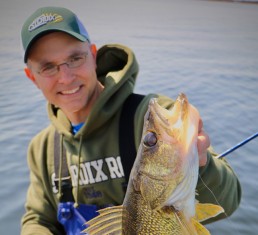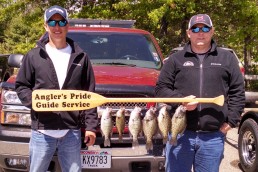Hard Bait Strategies for Post-Spawn Walleyes
SHARE THIS POST
One of the hallmarks of spring is the predictable movement of walleyes. On inland lakes, walleye slide into shallow waters along rocky, windblown shorelines to spawn. Major rivers see mass upstream migrations of walleyes, to be interrupted only by natural or manmade obstacles. And on the Great Lakes, fish funnel into primary tributaries to reproduce, and then systematically return to their home ranges.
Savvy anglers throughout the Walleye Belt can learn the rhythm of these movements and adjust their presentations throughout the pre-spawn/spawn/post-spawn cycle to enjoy success all spring, and into early summer.
The post-spawn period can be particularly rewarding. While walleyes may exhibit significant dispersive movements away from their spawning grounds, they also become increasingly catchable as warming waters increase their metabolic rates. During this period, anglers should focus on covering water with mobile presentations, often focusing on hard baits.

In states and provinces that have closed walleye seasons to protect vulnerable, spawning fish, the opening of the new season will generally find walleyes in this post-spawn phase. During the day, an excellent way to find and catch these walleyes is with shallow-running jerkbaits fished along shorelines and associated shallow flats. A presentation that works well until water temperatures creeping into the 60’s, shallow jerkbaits can be responsible for excellent catches during “banker’s hours”, especially on lakes or reservoirs with a touch of stain or color in their waters.
Shallow-running LIVETARGET Rainbow Smelt Jerkbaits are an excellent choice for post-spawn walleyes. These are extraordinarily detailed lures with three-dimensional anatomical features like fins, eyes, gill plates and scales, in addition to patterns, colors, transitions, and highlights that reflect Nature’s handiwork. Their tight shimmering action on the retrieve recalls the movements of a living baitfish, widely dispersing visual flash to attract predators over long distances.
Cast these jerkbaits very close to shore and work them back to the boat with a slow-and-steady or a stop-and-go retrieve. As darkness falls, these same lures can be long-line trolled along shorelines and across flats with great success, a pattern that will hold until extensive shallow weed growth hampers its effectiveness.

Rig for jerkbait fishing using a braided mainline, with 20 lb test Seaguar Smackdown being an excellent choice for spinning reels. On the stained waters where shallow daytime jerkbaiting is most effective, a leader is generally not required; simply tie on a cross-lock snap with a Palomar knot, clip in a jerkbait, and go fishing. On waters where extreme water clarity can make daytime walleyes skittish, a 3-foot leader of 15 lb test Seaguar AbrazX 100% fluorocarbon leader will help put more walleyes in the net.
Picking the right rod for presenting jerkbaits can dramatically enhance your spring walleye success. The Legend Tournament Walleye “Shallow Cranker” (LWS70MM) from St. Croix Rod is an outstanding choice for any shallow hard bait application, including jerkbaits. The 7-foot rod casts crankbaits a country mile, while its moderate action acts as a shock absorber against boatside headshakes, ensuring that fish stay buttoned up tight and end up in the net.
Are you enjoying this post?
You can be among the first to get the latest info on where to go, what to use and how to use it!
As Great Lakes walleyes disperse out of tributaries after the completion of their spawning runs, they frequently strap on the feedbag along near-shore sand flats. These areas warm rapidly in the springtime sun, and with the appropriate wind and current, also collect schools of baitfish and pods of omnipresent gobies. Post-spawn walleyes take advantage of these conditions to boost their calorie counts while recuperating from reproductive rituals.

Lipless rattlebaits, like the LIVETARGET Golden Shiner Rattlebait, are outstanding choices for targeting post-spawn walleyes in the Great Lakes. These baits excel at provoking aggressive reaction strikes from walleyes, especially when presented with an active rip-jigging motion. After a long cast, allow the rattlebait to settle to the bottom. Then, starting with the rod tip at the 9:00 position, rip the bait up rapidly until the rod is at the 11:00 position. Then, you can either follow the bait to the bottom on a semi-tight line, or let it fall on a slack line, an alternative that provides the bait with addition freedom to wobble as it swims toward the bottom.

Continue with this rip-fall rhythm on a steady cadence until the retrieve is complete. While you may feel the strike as the rattlebait falls toward the bottom, you are just as likely to not feel anything until you rip the bait upward on its next rise-fall cycle. Then, any resistance or weight means it’s time to set the hook – and set it hard!
Within the LIVETARGET Golden Shiner rattlebait family, the larger of the two sizes (2 7/8” and ½ oz) is preferred for beefcake Great Lakes walleyes. The smaller of the two sizes (2 3/8” and ¼ oz) is a good choice for inland waters, pressured fish, or post-frontal conditions when a more subdued presentation may be required. A selection of Silver/Black, Silver/Green, Gold/Black and Glow/Gold patterns of Golden Shiner rattlebaits will have you well on your way to post-spawn walleye success.
Line selection for presenting lipless rattlebaits is similar to that used for jerkbaits, with 20 lb test Seaguar Smackdown linked to 2 feet of 15 lb test Seaguar AbrazX 100% fluorocarbon leader being an excellent choice. Generally, however, a faster action rod is preferred when rip jigging rattlebaits, for bite detection, powerful hooksets, and to combat angler fatigue. Indeed, the Legend Tournament Walleye“Snap Jig” (LWS68MXF) rod from St. Croix Rod is an outstanding choice for this presentation. This 6-foot-8-inch, medium-power, extra fast action rod is the powerful backbone of many aggressive walleye techniques, excelling at ripping rattlebaits as well as snap-jigging soft plastics on heavy jigs.
The post-spawn period is no time to fish walleyes with a slow and steady demeanor. Rather, cover lots of water with aggressive, mobile presentations to locate pods of actively feeding fish. Go stretch the string this spring, and rip some post-spawn walleye lips, with jerkbaits and lipless rattlebaits!
MWO
SHARE THIS POST
Did you enjoy this post?
You can be among the first to get the latest info on where to go, what to use and how to use it!
MWO
We believe being outdoors is good. With more than 1,000 articles each year, MidWest Outdoors magazine is all about sharing outdoor experiences with you—where to go, what to use and how to use it… whether you’re close to home or on that trip of a lifetime.




